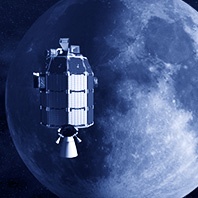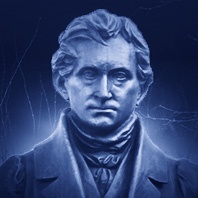Sir Charles Spencer Chaplin (1889–1977) is considered one of the first movie stars ever and made film history with his acting and his works. He is also one of the few artists who managed the transition from silent films to sound films.
Because of using archetypal imagery and symbols in his films, it is natural that the moon could also play a part somewhere. We found four references:
Read more
Luna 2 was a Soviet space probe that impacted the Moon on 13th/14th September 1959. Space probes are unmanned flying objects that are used for exploration. In this case, it was about exploring the Moon, with the goal to fly a human to the Moon and have them return safely. History shows that this did not become possible until ten years later, with the moon landing of Neil Armstrong within the framework of the Apollo 11 mission, in July 1969.
Read more
Fitting into the Christmas period, we are hanging up a virtual mistletoe and calling upon all lovers out there to kiss each other! The custom has a long tradition in many countries. The symbolism of fertility and vitality play as much a part as the search for the possibility of making the kiss in public socially acceptable. The mistletoe helps to overcome the inhibition, which can stand especially between two people before their first kiss. And incidentally, for every kiss one berry of the bush is plucked – until no berries are left.
Read more
Everyone knows that the sun is much larger than the moon and much further away from earth. In this very context lies a fascinating fact: both celestial bodies appear to be of similar size on the firmament, when observed from earth. Which implies that the sun has to be as many times bigger than the moon, as it is further away from the earth than the moon from the earth …
Read more
Are we alone in the universe? Are there other intelligent forms of life in space or are we alone? These questions have been on mankind’s mind, since we consciously reflect our existence and raise our gaze toward the starlit sky.
With the beginning of space travel, there arose the idea, of sending messages to potential extraterrestrial life. The question, which information is suitable, a representative picture of the entire human race and their lives on planet Earth, is particularly exciting.
Read more
Japanese woodblock prints have a centuries-long tradition and stand for high quality craftsmanship and artistic expressiveness. In particular, when realizing that this printing technique has been practiced since the 8th century (when letterpress printing in Europe was still a distant prospect), it becomes clear what kind of cultural achievements can be associated with this. A woodblock print works just like a stamp that has been carved into a block of wood. Then the color is applied onto the wood and printed onto paper. If you want to print a variety of colors on top of each other, you need a separate woodblock per each color and hence receive the characteristic depth effect.
Read more
A moon bridge is a pedestrian bridge, of which the semicircular arch completes a full circle through its reflection in the water and reminds of the full moon. In the old days, the high arch especially, served the purpose for barges to comfortably pass through underneath. Moon bridges originate in the Asian culture and were often built in Japanese and Chinese gardens. The mostly used materials were wood, stone and metal.
Read more
As reported back in September 2013, NASA sent the lunar probe LADEE (short for: Lunar Atmosphere and Dust Environment Explorer) into space, to circle and to explore the Moon. Especially, the formation of ice at the lunar poles has been of great interest. The space probe also collected measurement data of dust particles and gases that are close to the Moon’s surface.
Read more
The terminology »void of course« Moon (VOC), refers to a specific duration of time in astrology, during the Moon’s passage through the signs of the zodiac. To this, the basic conditions are created by the so called »aspects« of the Moon, which refers to its connection to other planets in the sky. For example, when the Moon and another planet are opposite to each other, it is called »opposition«. Further important aspects are »conjunctions« (next to each other), »square« (angular distance 90°), »trine« (120°) and »sextile« (60°). So when the Moon passes through a zodiac, various of these aspects surface. After approximately 2.5 days, the Moon changes into the next zodiacal sign, to create new aspects again. The phase between the last aspect in the current zodiac and the transition to the next zodiac is called »void of course / VOC«. The length of this void of course can take anything from two minutes up to two days.
Read more
The German poet and novelist Joseph Freiherr von Eichendorff (1788–1857) counts among the foremost representatives of Romanticism. Many of his poems had been set to music and were sung.
Von Eichendorff, born in Ratibor (today Racibórz in Poland), studied originally law and worked in a variety of administrative civil service positions, up until he retired. Simultaneously, he devoted his time to his writing and publishing skills, until he died from pneumonia in 1857.
Read more
The new moon is the opposite pole to the full moon, being the time when the Moon is not visible in the sky to us people. Maybe this is why we pay less attention to it, because what you don’t see is less prevalent in our awareness.
However, there is one aspect, which continues to lend significance and fascination to the new moon. It is the word »new« and the described moment of renewal and of a new beginning. This word can be found in different languages:
Read more










